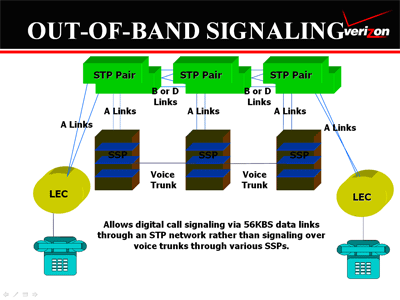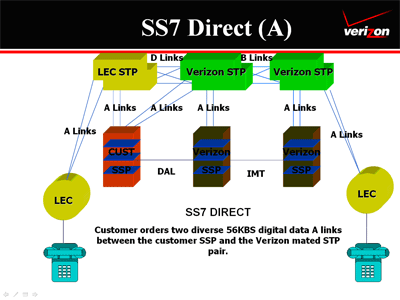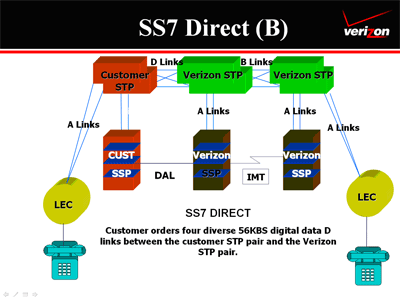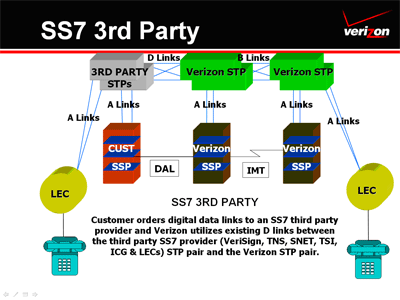SS7
Why Verizon?
Verizon's SS7 network offers carriers the ability to interconnect at one or more of our strategically located signal transfer point (STP) pairs and open the door to a multitude of new service offerings that your customers value.
"By connecting with Verizon, you can take advantage of one of the world's most advanced SS7 networks without the enormous costs of deploying and maintaining your own SS7 network."
Product Manager - Peter D'Amico
- Overview
- Service Details
- Diagram
- Take Action
Introduction
Partner with Verizon Enterprise For Fast Connectivity
Signaling System 7 (SS7) products provide SS7 connectivity between your network and our network. SS7 provides out-of-band signaling for dedicated carrier traffic, reducing call set-up time and dedicated access demands. With our SS7 products, you can have both the rapid transmission and critical network reliability that your business needs, without the expense of developing an independent SS7 network.
How It Works
Inter-machine connections such as Feature Group D (FGD) trunks and Dedicated Access Lines (DALs) between telecommunication switches use one of two types of signaling: In-band (Dial Pulse, DTMF or MF) signaling, or Out-of-Band signaling (OBS). When In-band signaling is used, the signaling information such as off hook, digits dialed, calling number, etc., is routed over the same path as the voice traffic. OBS signaling uses a separate data network for the call setup messages, while the voice, data or any bearer traffic traverses the inter-machine connections via FGD or DAL type trunks.
Common Channel Signaling 7 (CCS7), also known as Signaling System #7 (SS7), is the OBS signaling currently being used. SS7 is an international standard defined by the International Telecommunication Union-Telecommunication (ITU-T) sector. ITU-T is the international organization that defines standards for telegraphic and telephone equipment.
An SS7 network is made up of different elements.
STP: Signal Transfer Point
STP is a packet switch that serves as a router in the SS7 network. Some of its functions are:
- Routing SS7 messages between switches
- Performing Gateway Screening
- Serving as a connection point to another network
SSP/SP: Service Switching Point
SSP is a local exchange in the telephone network. An SSP can be a combination voice switch and SS7 switch, or an adjunct computer connected to the switch. Some of its functions are:
- Converting voice switch signaling to SS7 signaling
- In the case of database access, the SSP will be sending database queries through the SS7 network to computer systems located centrally to the network.
SCP: Service Control Point
SCP is an interface to the telephone company databases and provides access to such databases.
Signaling Links
Signaling links are the digital paths that the SS7 data messages travel through, and are 56Kbps Digital Data Signal (DDS) type.
Benefits
- Provides wholesale customers with call setup connectivity via a premier, highly survivable, continually monitored digital network.
- Verizon provides customers three levels of service or applications to choose from based on their needs and supportability.
Applications
- SS7 Direct allows your switches to interface with our advanced SS7 network via 56 Kbps digital data links to deliver call set-up information for your Carrier Origination and Carrier Termination traffic. Dedicated links provide security and control of your signaling.
- SS7 Third Party allows your switches to interface with our SS7 network without establishing customer direct links to our network. Your connections to a third-party SS7 provider interface with our connections to the same third-party provider to deliver call set-up information for your Carrier Origination and Carrier Termination traffic.
Availability
SS7 services are available with Carrier Termination, Carrier Origination, End User Dedicated 1+ and End User Dedicated Toll Free services.
Pricing
SS7 Direct and SS7 Third Party each have unique charges depending on the set-up requested. Please contact Verizon for additional information on these charges.
Features
- Quick call set-pup time promotes your high-quality image.
- Out-of-band signaling reduces your dedicated-access facility demands. SS7 support for Feature Group D call types, including 1+, toll-free, 900 and 0+, helps control access costs for your entire switched product line.
- SS7 Local Access and Transport Area (LATA) connectivity provide network redundancy and the transmission reliability and nationwide coverage on which your business depends.
- Fully meshed Signal Transfer Point (STP) pairs throughout the country and T1 quad-link connections between STPs provide you with easy access to our SS7 network.
- SS7 support of both inbound and outbound traffic to/from your switch help control access costs for your entire dedicated product line.
- Signaling Network Management System provides around-the-clock automated and live monitoring to help prevent network trouble.




To learn more about this service, please contact us or call your account manager today.
